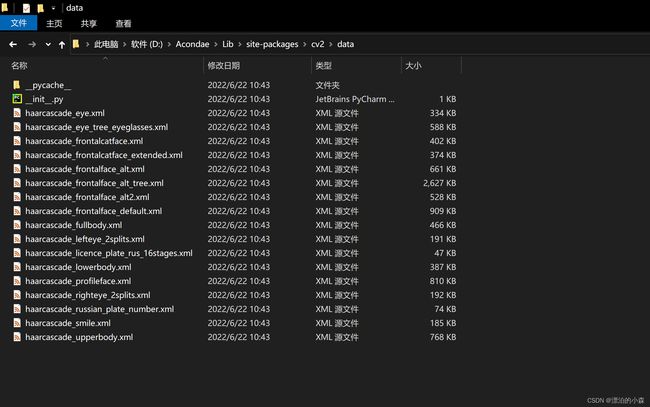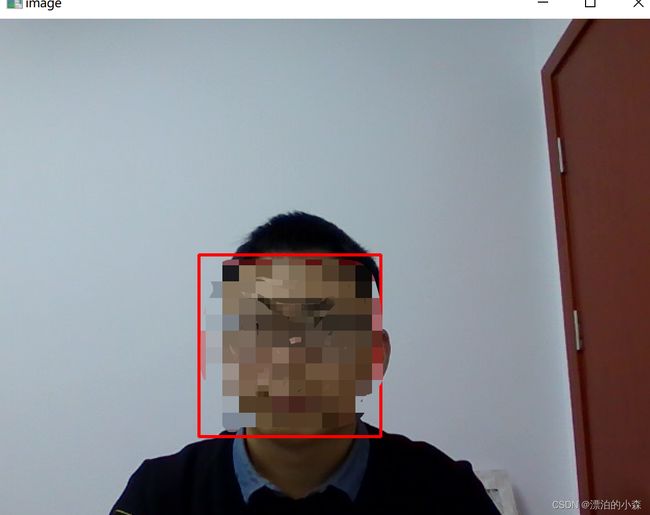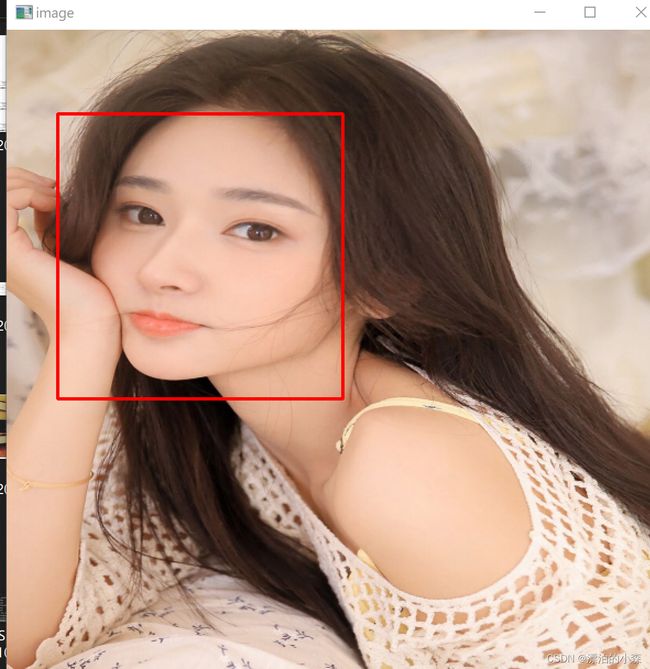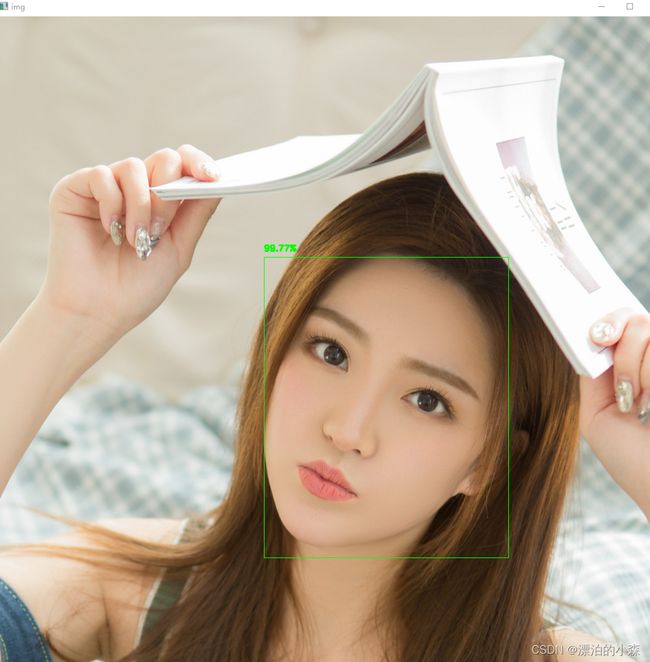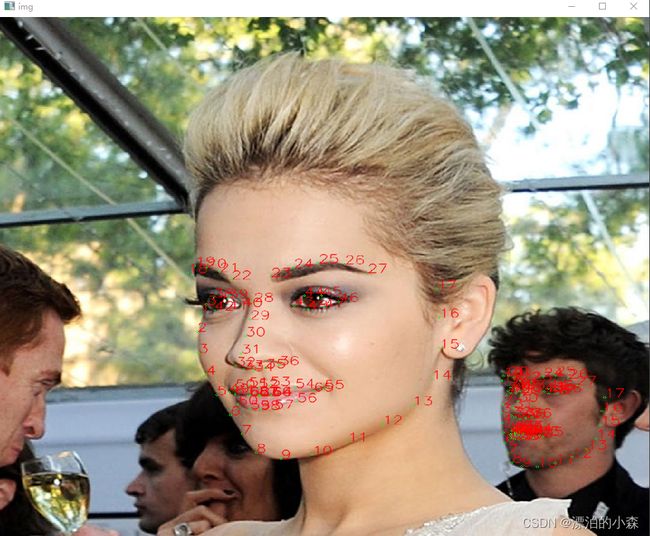关于人脸检测和人脸关键点检测的详解(涉及Opencv 和Dlibd)
关于人脸识别,大家入门opencv,最常见的是用opencv级联分类器器里面的函数进行人脸的识别(当然里面包含很多各种物体的分类器,大家可以一一测试),今天我们来练一下关于人脸识别的级联器。
1,opencv +Haar Cascade(人脸检测)
①首先要找到人脸检测级联器的xml文件,打开你的电脑,在你安装的python-opencv的库里面,打开data文件,就可以看到很多级联器的xml文件,选择自己要用的文件,给复制到python文件的同一目录下:
②运行脚本文件.py进行人脸检测(摄像头或者视频下检测)
import cv2
video=cv2.VideoCapture(0)#打开摄像头
face_fea=cv2.CascadeClassifier('haarcascade_frontalface_alt.xml')#用级联器打开人脸特征识别算法
while True:#while True 语句中一定要有结束该循环的break语句,否则会一直循环下去的。
open,image=video.read()
if not open:
print('视频结束')
break
#图片灰度化
gray=cv2.cvtColor(image,cv2.COLOR_BGR2GRAY)
face=face_fea.detectMultiScale(gray)
for x,y,w,h in face:
cv2.rectangle(image,pt1=(x,y),pt2=(x+w,y+h),color=[0,0,255],thickness=2)
frame = cv2.flip(image, 1) # 摄像头是和人对立的,将图像左右调换回来正常显示。
cv2.imshow('image',frame)
key=cv2.waitKey(1000//24)
if key==ord('q'):#q的啊克斯吗
print('用户达到自己的需要')
break
cv2.destroyAllWindows()
video.release()#释放摄像头资源就可以检测到人脸图像:
③当然也可以检测图片上的人脸了,运行脚本:
import cv2
image=cv2.imread('222.jpg')
image=cv2.resize(image,(600,800))
face_fea=cv2.CascadeClassifier('haarcascade_frontalface_alt.xml')#用级联器打开人脸特征识别算法
#图片灰度化
gray=cv2.cvtColor(image,cv2.COLOR_BGR2GRAY)
face=face_fea.detectMultiScale(gray)
for x,y,w,h in face:
cv2.rectangle(image,pt1=(x,y),pt2=(x+w,y+h),color=[0,0,255],thickness=2)
cv2.imshow('image',image)
cv2.waitKey(0)
运行结果:
2,opencv+DNN(结合了深度学习,backbone是resnet-10网络),其实算法源自于一篇SSD论文,有兴趣的可以去拜阅。
里面的权重文件下载地址:
https://github.com/61a6d591-1197-4b21-8b78-bce27de63399
OpenCV/opencv_3rdparty at dnn_samples_face_detector_20180205_fp16 (github.com)![]() https://github.com/opencv/opencv_3rdparty/tree/dnn_samples_face_detector_20180205_fp16
https://github.com/opencv/opencv_3rdparty/tree/dnn_samples_face_detector_20180205_fp16
①实现对图片的检测
import numpy as np
import cv2, os
def show_detections(image, detections):
h, w, c = image.shape
#里面包含了人脸框的信息,还有置信度,分类等指标
for i in range(0, detections.shape[2]):
confidence = detections[0, 0, i, 2]
if confidence > 0.6:#置信度
box = detections[0, 0, i, 3:7] * np.array([w, h, w, h])
(startX, startY, endX, endY) = box.astype("int")
y = startY - 10 if startY - 10 > 10 else startY + 10
cv2.rectangle(image, (startX, startY), (endX, endY),(0, 255, 0), 1)
cv2.putText(image, "{:.2f}%".format(confidence * 100), (startX, y),cv2.FONT_HERSHEY_SIMPLEX, 0.45, (0, 255, 0), 2)
return image
def detect_img(net, image):
# 对图像进行预处理,减均值,图像缩小为(300,300),通道处理
blob = cv2.dnn.blobFromImage(image, 1.0, (300, 300), (104.0, 177.0, 123.0), False, False)
#输入给网络模型,进行一次前向传播
net.setInput(blob)
detections = net.forward()
return show_detections(image, detections)
#图片
def test_file(net, filepath):
img = cv2.imread(filepath)
showimg = detect_img(net, img)
cv2.imshow("img", showimg)
cv2.waitKey(0)
net = cv2.dnn.readNetFromCaffe("deploy.prototxt", "res10_300x300_ssd_iter_140000_fp16.caffemodel")
test_file(net,'R-C.jpg')运行结果:
②实现对视频的人脸检测:(可以选取自己喜欢的视频放进去检测)
import numpy as np
import cv2, os
def show_detections(image, detections):
h, w, c = image.shape
#里面包含了人脸框的信息,还有置信度,分类等指标
for i in range(0, detections.shape[2]):
confidence = detections[0, 0, i, 2]
if confidence > 0.6:#置信度
box = detections[0, 0, i, 3:7] * np.array([w, h, w, h])
(startX, startY, endX, endY) = box.astype("int")
y = startY - 10 if startY - 10 > 10 else startY + 10
cv2.rectangle(image, (startX, startY), (endX, endY),(0, 255, 0), 1)
cv2.putText(image, "{:.2f}%".format(confidence * 100), (startX, y),cv2.FONT_HERSHEY_SIMPLEX, 0.45, (0, 255, 0), 2)
return image
def detect_img(net, image):
# 对图像进行预处理,减均值,图像缩小为(300,300),通道处理
blob = cv2.dnn.blobFromImage(image, 1.0, (300, 300), (104.0, 177.0, 123.0), False, False)
#输入给网络模型,进行一次前向传播
net.setInput(blob)
detections = net.forward()
return show_detections(image, detections)
#视频或者摄像头
def test_camera(net,filepath):
cap = cv2.VideoCapture(filepath)
while True:
ret, img = cap.read()
if not ret:
break
showimg = detect_img(net, img)
cv2.imshow("img", showimg)
cv2.waitKey(1)
net = cv2.dnn.readNetFromCaffe("deploy.prototxt", "res10_300x300_ssd_iter_140000_fp16.caffemodel")
test_camera(net,'20220919214835.mp4')
3,Dlib人脸检测,并返回68个坐标点。
权重文件:http://dlib.net/files/shape_predictor_68_face_landmarks.dat.bz2
#这个代码负责把图片进行68个特征点的提取,然后将关键点制作成txt文件。
import numpy as np
import cv2
import dlib
#DLIB官网下载的68个特征点的训练模型文件
#人脸检测模型
detector=dlib.get_frontal_face_detector()
#正脸68个关键点检测模型
predictor = dlib.shape_predictor('shape_predictor_68_face_landmarks.dat')
#face_descriptor=dlib.face_recognition_model_v1('dlib_face_recognition_resnet_model_v1.dat')
# cv2读取图像
img = cv2.imread("223.jpg")
print(img)
# 取灰度
img_gray = cv2.cvtColor(img, cv2.COLOR_RGB2GRAY)
# 人脸数rects
rects = detector(img_gray, 1)
for i in range(len(rects)):
landmarks = np.matrix([[p.x, p.y] for p in predictor(img,rects[i]).parts()])#对坐标进行遍历
for idx, point in enumerate(landmarks):
# 68点的坐标
pos = (point[0, 0], point[0, 1])
print(idx,pos)
#利用cv2.circle给每个特征点画一个圈,共68个
cv2.circle(img, pos, 2, color=(0, 255, 0))
#利用cv2.putText输出1-68
font = cv2.FONT_HERSHEY_SIMPLEX
cv2.putText(img, str(idx+1), pos, font, 0.8, (0, 0, 255), 1,cv2.LINE_AA)
cv2.namedWindow("img", 2)
cv2.imshow("img", img)
cv2.waitKey(0)
cv2.destroyAllWindows()
运行结果;
如果做人脸特征点检测,需要训练自己的人脸数据,不想手动标注文件这么麻烦的话,我觉得可以用这个dlib的68关键点检测对自己的数据进行打标处理。
